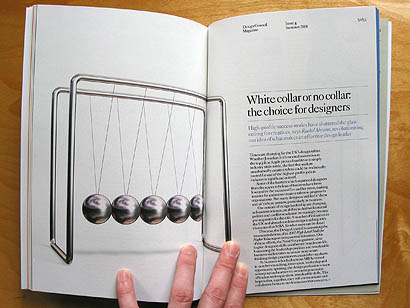
There is an institution in the United Kingdom called the Design Council. A government-funded organization, the Council’s mission is “to help UK managers become the best users of design in the world, supported by the most skilled and capable design professionals.”
This objective makes it sound like they’re a professional guild or advocacy organization, like America’s AIGA, but the Design Council differs in two ways: First, they are government-funded, which means there is no American equivalent. Second, they have no membership (or membership fees). The Design Council exists to help advance British design, period.
I’m not British, of course, but Rachel Abrams is. The Design Council invited Rachel to contribute an article to their bi-annual (and limited-edition print-only) Design Council Magazine about the role of the designer in the world of business, in particular on how designers can be influential in the higher layers of the business decision making process. This is a subject I have no small interest in, what with my debate a few months ago with Bruce Nussbaum at BusinessWeek and with my workshop session at this year’s IA Summit in Miami.
I’m honored to have been one of several people interviewed by Rachel for the article. My contribution was mostly to discuss how core design skills are applicable to macro-level business skills.
My favorite part of the article, however, is IDEO’s Mat Hunter‘s observation that “The point at which an organisation moves beyond operational efficiency and problem-solving toward opportunity-finding is the point where there is room for designers to lead.” Indeed, it’s hard to imagine a designer playing an instrumental role in the direction of their business if the business is focused on solving existing problems and exploiting known opportunities. I wish I’d thought of that.
The article is not online, so (unless I get in trouble for this) you can view the article in PDF form here.
Comments
One response to “Design Council Counsellor”
it’s a thought but what if thinking creatively is the solution to an existing problem.
have heard quite a number of business owners citing that to just survive in day-to-day running of businesses, they can’t afford any the time and cost of a designer in their business to bring it up to the next level.
but then would think to myself, what if bringing the designer in addressing the problem might help solve it and allow the business to move on?
well, I’m not a proper business owner so perhaps there are plenty of other factors in situation like this:)